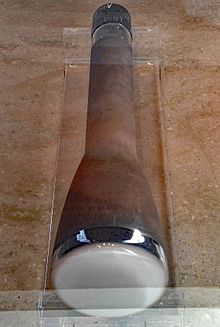IBM 701
The mainframe computer IBM 701 belonged to the 700/7000 series from IBM and came onto the market in 1952. It was the first IBM computer designed for scientific purposes. The versions for business customers were the IBM 650 and IBM 702 . The computer marks the transition to fully electronic computers at IBM.
history
There were already some partially electronic predecessors at IBM, the Automatic Sequence Controlled Calculator (ASCC) from the 1940s and the Selective Sequence Electronic Calculator (SSEC) from 1948 (with vacuum tubes and relays), but the 701 was only a quarter the size of the SSEC and was 25 times faster.
A total of 19 systems were installed. Since it mainly included customers from the US armaments complex, it was also called the Defense Calculator . Thomas J. Watson had only expected orders for five machines, which he said, for example, at the 1953 shareholders' meeting on the occasion of the introduction of the IBM 701 (this may have resulted in the often incorrect but probably attributed quote I think there is a world market for maybe five to Watson computers ). Before production of the 701 began, he visited twenty potential customers and came back with 18 orders. Among other things, the Lawrence Livermore National Laboratory at the University of California received a system. A compiler was also developed there, called KOMPILER . IBM's own Fortran compiler did not come onto the market until 1954 with the IBM 704.
Leading developers included Nathaniel Rochester , Jerrier A. Haddad, and Werner Buchholz , who were head of engineering at IBM W. Wallace McDowell . The design should stick as closely as possible to the design by John von Neumann , as it was realized in his IAS computer or the JOHNNIAC .
At that time it had competition from the ERA in 1103 by Remington Rand , which secretly for the NSA to be developed and in 1953 got permission marketed. The US Department of Defense performed a numerical weather forecast benchmark test for both machines with slight advantages for the IBM system.
On the 701 one of the first computer programs for artificial intelligence was running , a checkers program by Arthur Samuel . Translation programs from Russian also ran on the 701 in 1954. The successor was the IBM 704 , which was introduced in 1954 (the business customer versions were the IBM 702 , IBM 705 ).
System description
- Memory: electrostatic storage with 72 Williams tubes , which could each store 1024 bits , corresponding to a memory of 2048 words of 36 bits each. The memory was named IBM 706. The clock rate of the memory was 12 microseconds. The memory could be doubled with 72 additional tubes (to 4096 words). There were also drum memories and magnetic tapes as storage media ( magnetic core memories only appeared in the era of the successor).
- The commands were 18 bits long with a single address. 33 different commands could be executed.
- The numbers (which were internally binary coded) were in fixed-point format and were 36 or 18 bits long with a sign .
- The machine had two programmer accessible registers : an accumulator (38 bits with 2 overflow bits) and a multiply / divide register of 36 bits.
- The input and output devices were punch card readers and printers, printers, input and output on magnetic tape ( IBM 726 tape drive ) or magnetic drum. The new magnetic tape readers in particular contributed to the success of the IBM 701.
Web links
References and comments
- ↑ Public announcement by IBM on May 21, 1952. First commissioning for customers took place in 1953.
- ↑ Customer list at IBM
- ↑ It is often ascribed to Watson 1943, but there was no evidence for this statement. One statement relates to the said 1953 meeting of shareholders in connection with the 701st Kevin Maney: The Maverick and his machine. Thomas Watson Sr. and the making of IBM , Wiley 2003, pp. 355f
- ^ Page from IBM to the developers . Managers like Ralph Palmer and Cuthbert Hurd also advised on the decision to develop .
- ^ Dunwell, Oral History Interview 1989
- ^ Emerson W. Pugh: Building IBM , MIT Press 1995, p. 174
- ^ IBM History 1956
- ^ Page from IBM on early translation programs on the 701
- ^ Page from IBM on the 704
- ↑ IBM website describing the computer


